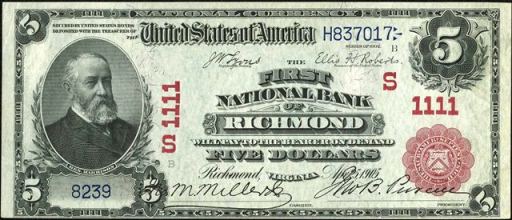The Aurora National Bank Of Aurora
The Aurora National Bank Of Aurora in Indiana printed $204,230 dollars worth of national currency. That is a small output. National bank notes from here should be scarce. This national bank opened in 1883 and stopped printing money in 1907, which equals a 25 year printing period. That is a fairly normal lifespan for a national bank. During its life, The Aurora National Bank Of Aurora issued 6 different types and denominations of national currency. We have examples of the types listed below. Your bank note should look similar. Just the bank name will be different. For the record, The Aurora National Bank Of Aurora was located in Dearborn County. It was assigned charter number 2963.
We buy all national currency. Please call or email us for a quote. Sales@AntiqueMoney.com
The Aurora National Bank Of Aurora in Indiana printed 2,499 sheets of $5 1882 brown back national bank notes. That sheet output number is small. Don’t expect too many of these to be available to collectors. You can take the total number of sheets printed and multiply that number by four to get the exact number of 1882 $5 brown back bank notes this bank issued. Each note has a portrait of James Garfield on the left hand side of the bill. These are very popular with collectors because they have different text layouts. Some notes are worth as little as a few hundred dollars, but most are worth a good deal more.
Series of 1882 $5 Brown Back
The Aurora National Bank Of Aurora printed 2,197 sheets of $10 1882 brown back national bank notes. That sheet output number is small. Don’t expect too many of these to be available to collectors. There were three $10 bills printed on a single sheet of 1882 brown backs. The design of the bill is similar to all earlier ten dollar national bank notes. The nickname comes from the fact that these bills have a brown seal and brown overprint. Despite saying series of 1882, these were actually printed by some banks up until 1908. The date you see in cursive relates to when the bank first started issuing brown back notes.
Series of 1882 $10 Brown Back
The Aurora National Bank Of Aurora also printed 2,197 sheets of $20 1882 brown back national bank notes. As you can see, the sheet output is the same for $20 brown backs as it is for $10 brown backs. There was only one $20 brown back printed on a sheet. So the sheet output also equals the total note output. One neat thing about all brown backs is that they each have a different back design based on which state issued them. The back left hand side of the note shows the state seal of which ever state the national bank was located in. Generally speaking, 1882 $20 brown backs are pretty difficult to locate. They typically were printed in small numbers and they don’t have a great survival rate.
Series of 1882 $20 Brown Back
The Aurora National Bank Of Aurora also printed 790 sheets of $5 1902 red seal national bank notes. All red seals are very rare. But that sheet output is extremely low. We would love to see a picture of what you have. Five dollar red seals are typically a little bit rarer than some higher denominations. That rarity is typically just a result of small issuances. Most national banks preferred to issue $10 and $20 1902 red seals. Each one of these five dollar bank notes has a portrait of Ben Harrison on the left hand side of the bill. Most people are quick to notice the cursive charter date with a year between 1902 and 1908 written on it. That date will never affect the value.
1902 $5 Red Seal National Bank Note
The Aurora National Bank Of Aurora also printed 572 sheets of $10 1902 red seal national bank notes. All red seals are very rare. But that sheet output is extremely low. We would love to see a picture of what you have. Collectors love ten dollar 1902 red seals. They usually represent the rarest bank notes printed by any national bank. Don’t let the term “series of 1902” confuse you. These were actually printed for about six years between 1902 and 1908. That is obviously a very short issue period which means that many red seals are quite rare. Each note has a portrait of William McKinley. Be sure to check the number under McKinley. If it is #1 then you are dealing with a note from the first sheet of bank notes issued. Number one bank notes are worth even more money than the already rare red seals.
1902 $10 Red Seal National Bank Note
The Aurora National Bank Of Aurora also printed 572 sheets of $20 1902 red seal national bank notes. Twenty dollar red seal bank notes have poor survival rates. They don’t command premiums compared to the ten dollar denomination, but they are definitely rarer. All 1902 red seals were printed on four note sheets. There were three ten dollar bills and one twenty dollar bill per sheet. The 1902 $20 notes have a portrait of Hugh McCulloch on them. The charter number and seal are both printed in red ink. The serial numbers have a slight blue tint to them. The charter number is printed around the border of the note several times. The bank’s title is right in the middle of the note and the state of issue is printed just below the title. Remember that all national bank notes are valued based on their condition and rarity. The same rule applies to 1902 $20 red seals.
1902 $20 Red Seal National Bank Note



